A birthday salute to the late Mike Sekowsky, who was born 98 years ago…
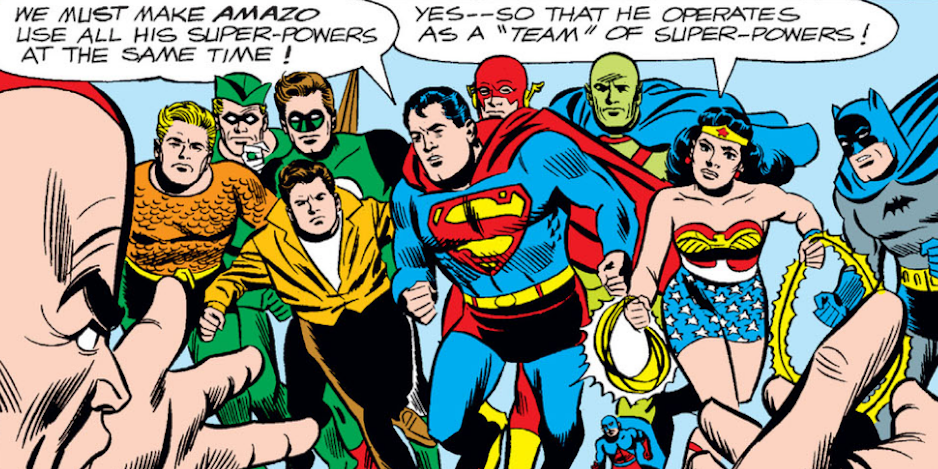
JLA #27, inks by Bernard Sachs
—
UPDATED 11/19/21: The late Mike Sekowsky was born 98 years ago. Perfect time to re-present this 2020 piece by columnist Paul Kupperberg. And for a new 13 COVERS birthday celebration, click here.
—
By PAUL KUPPERBERG
As far as I knew, Mike Sekowsky (Nov. 19, 1923 – March 30, 1989) was born drawing the Justice League of America for DC Comics. So much so that in the early 1970s, when he penciled a few Inhumans stories, I remember thinking how terribly out of place he seemed to be at Marvel.
I was amazed to discover that, in fact, most of Sekowsky’s first 15 years in the business had been spent at Marvel, then called Atlas, starting in 1942 on strips ranging from “Father Time,” a feature in Captain America to Cap himself, as well as Namor, the Human Torch and Young Allies. Post-superheroes, he worked on the company’s mystery, humor and romance titles.
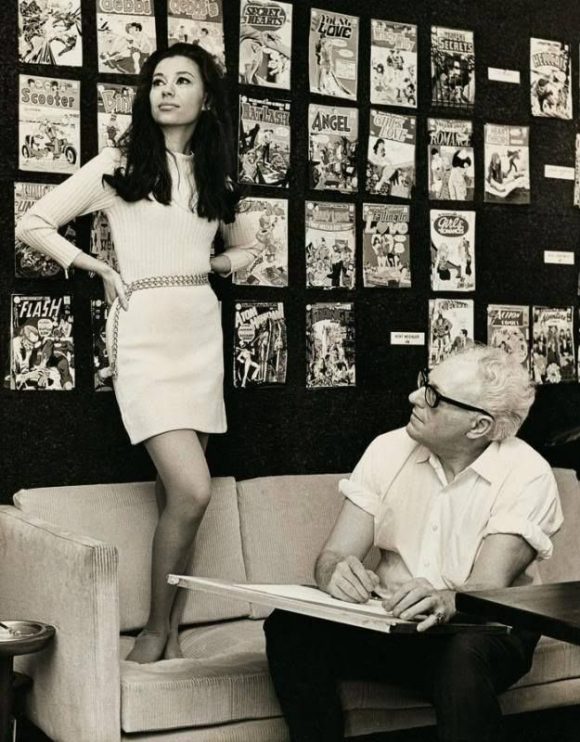
Sekowsky drawing Wonder Woman model Joyce Miller
By the time I became a reader, Sekowsky’s style was, if not out of place, at least out of step with the majority of artists of that era. Especially among the stable of more realistic pencilers most frequently used by JLA editor Julie Schwartz. But Sekowsky was right there in the Schwartz rotation, along with Gil Kane, Joe Kubert, Carmine Infantino and Murphy Anderson, his squat, somewhat stiff figures standing alone in a world of otherwise anatomically correct compatriots.
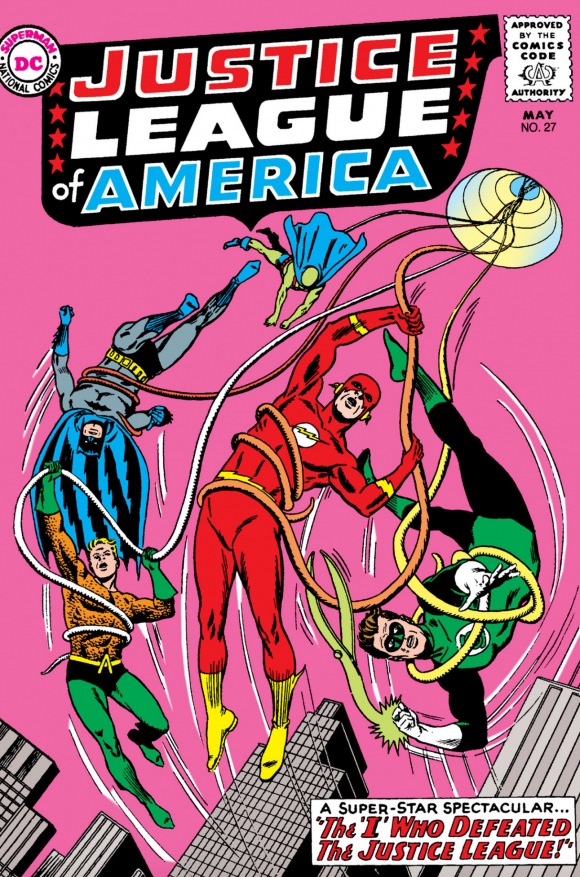
Murphy Anderson inks
I once asked Julie Schwartz how he came to tag Mike Sekowsky – who at the time had been drawing mostly romance and science fiction stories — to pencil the Justice League of America for Brave and the Bold #28 (Feb.-March 1960). Julie said, “Because he was the only one willing to draw a book with 10 regular characters that you had to fit into every damned panel of the story.”
Julie exaggerated for comedic effect, but the truth is, despite his wonky take on the human body, Mike Sekowsky was one hell of a comic book storyteller. His characters carried weight and barreled ahead as though shot out of a cannon. Even those static shots of 10 or 15 heroes mingling in the JLA HQ bustled with activity and little bits of business that sprang out of the characters he was working on.
I could fill this list with just issues of one of my favorite Silver Age titles, Justice League of America, which Sekowsky drew for 66 issues (the three tryouts in B&B and JLA #1–63, from Oct./Nov. 1960 to June 1968), but there’s plenty more to choose from in his more than 40-year career:
—
1. The Brave and the Bold #28 (Feb./March 1960): Up until this time, the only DC superheroes who were allowed to meet face-to-face were Superman and Batman in the pages of World’s Finest Comics. Now, they were joined by Wonder Woman, the Flash, Green Lantern, Martian Manhunter and Aquaman in one great big team which — to a young reader like me who had no idea of their Golden Age predecessor team, the Justice Society of America — was like the discovery of electricity.
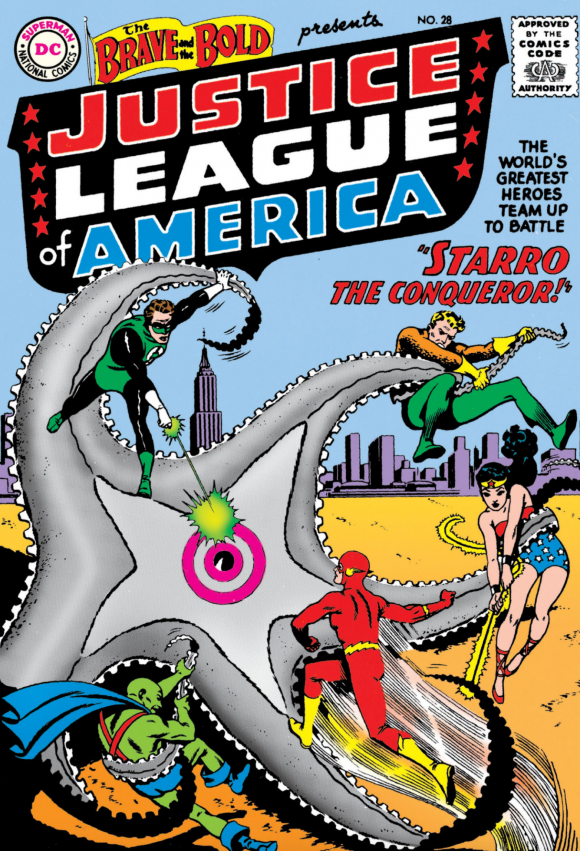
Murphy Anderson inks
I think my first issue of JLA was around #27 (May 1964). I was attracted to the book at first because it featured a recently discovered favorite, John Jones, the Manhunter from Mars, but I stayed for the jam-packed, science fiction adventure stories by Gardner Fox and the amazing art by Sekowsky and inker Joe Giella. As good a job as Dick Dillin did in replacing him, I felt the JLA lost a vital bit of spark and energy without Mike Sekowsky.
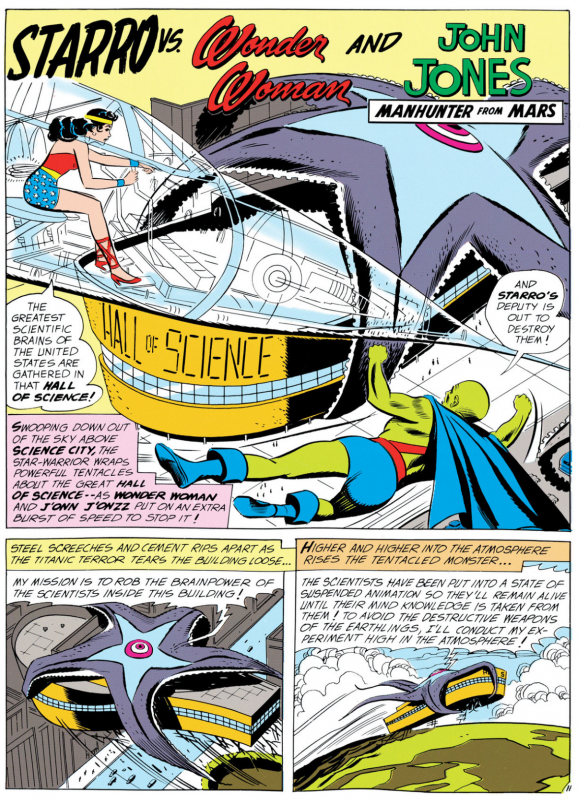
Bernard Sachs inks
—
2. Showcase #66-67 (Jan./Feb. – March/April 1967). B’wana Beast was nuts! White guy in Africa gets a helmet and a serum from a purple gorilla (who you can be sure appeared on the cover) that not only allows him to control the wild beasts of the jungles, but also merge as many as four animals into a single mega-creature, a chimera, possessing the properties of them all. There was also a giant robot crocodile (or something).
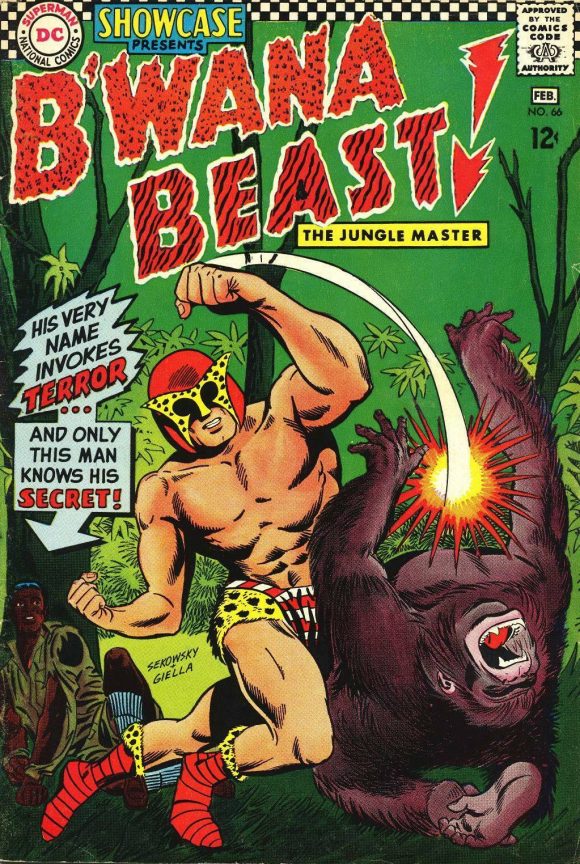
Joe Giella inks
There seems to be some question as whether it was Bob Haney, or maybe even Sekowsky himself, who created/wrote this cheesy, amped-up Tarzan wannabe… although I’ve also heard that Sekowsky refused to continue drawing the strip because of its racist overtones, a rumor whose veracity I fervently hope for. But 12-year-old me in 1967 didn’t know from racist content; B’wana Beast belonged to the same “white savior in Africa” genre as those old Tarzan (and every other jungle adventure) movies I’d ever seen. For me, B’wana Beast was just a nonstop, headlong plunge over Victoria Falls.
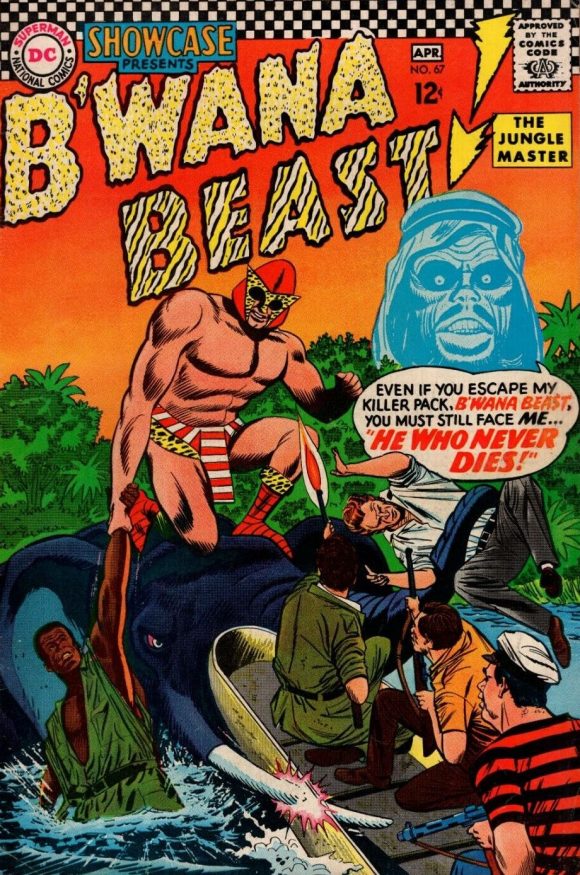
Jack Abel inks
It’s hard to tell where Sekowsky’s head was on this one. The storytelling, as always, is there, but some of the drawing tipped over almost into parody, as in several shots of B’wana Beast loping along that look like they belonged in one of his humor strips and not an adventure story. But that’s coming at it from a perspective 53 years after the fact. What does remain with me was laying on my stomach in my grandmother’s living room in Brooklyn reading and rereading it in wonder one winter Sunday afternoon.
—
3. Showcase #68–69, #71 (May/June – July/Aug., Nov./Dec. 1967). Speaking of the funny, Sekowsky drew that too. Lots of it, including the Maniaks, created with writer E. Nelson Bridwell. The Maniaks were Jangle, Silver Shannon, Packrat, and Flip, a rock and roll foursome who played at the (real) Palisades Amusement Park in New Jersey, a longtime advertiser in DC Comics.
The Maniaks was pretty funny for the time. DC assistant editor, writer, and staff historian Bridwell had broken into the business selling gags to Mad Magazine so he knew his way around a joke, and Sekowsky could contort his already exaggerated forms into even funnier comedic shapes to carry them.
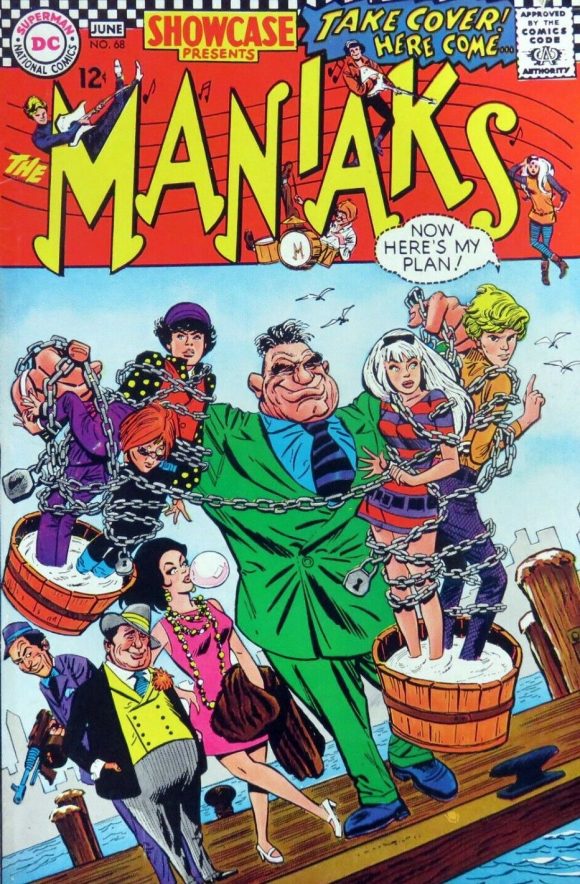
Mike Esposito inks
Though I doubt any mid-1960s comic book written by middle-aged white men could ever really be called “hip” (except in the most tragically ironic sense), the Maniaks somehow got rising comedy star Woody Allen to agree to “guest-star” in their third and final appearance. The young Broadway writer/director hired the Maniaks to star in his upcoming Broadway musical, “Confederate Yankees,” complete with many great groan-worthy song parodies.
Two of the three issues featured “Go-Go Checks” on the cover. It was groovy, man. Or at least as close as comic books came to it in those days.
—
4. Metal Men #32-41 (June/July 1968–Dec. 1969/Jan. 1970). Somewhere around 1968, Mike Sekowsky became one of the go-to guys for titles that needed a freshening up or a new direction. When Jack Miller was handed Metal Men from previous editor (and co-creator, with Ross Andru and Mike Esposito) Robert Kanigher, he kept Kanigher but changed the book’s direction and replaced Andru and Esposito with Sekowsky.
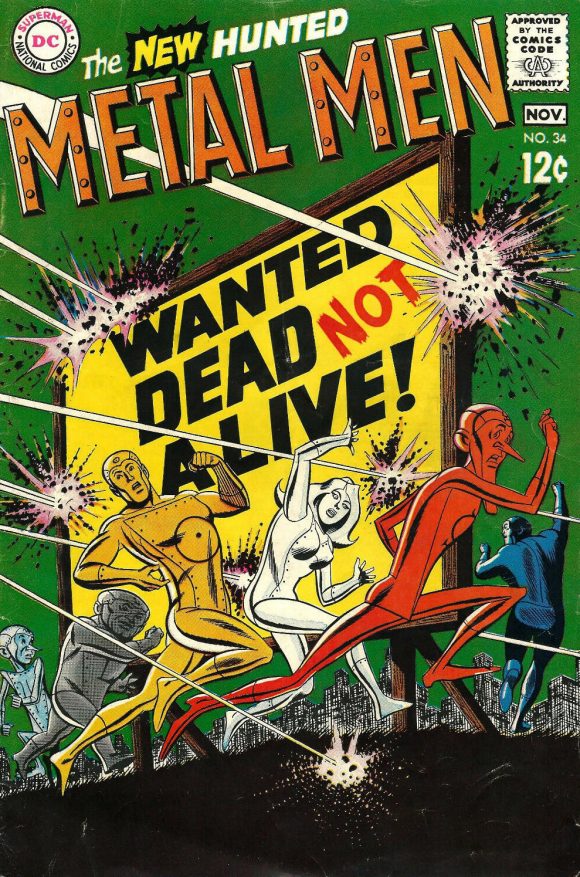
Abel inks
No question Sekowsky’s art helped freshen the look of the book, and the ongoing story of “the new hunted Metal Men” was a welcome change of pace from the earlier monster/creature/robot menace of the bi-month. Sekowsky took over editing and writing with #38, but he could only keep the book limping along for less than a year before it was cancelled by the end of 1970.
—
5. Wonder Woman #179-197 (November/December 1968 – November/December 1971). Editor Jack Miller next sicced Sekowsky on another Kanigher title that was long overdue for a makeover. Bob had been at the helm of Wonder Woman as writer-editor since 1948 and had discarded her feminist roots (Bob was not a feminist!) in favor of silly, romantic fairy tales, before trying to shift gears again in the mid-1960s to catch up with the developing trends of the day.
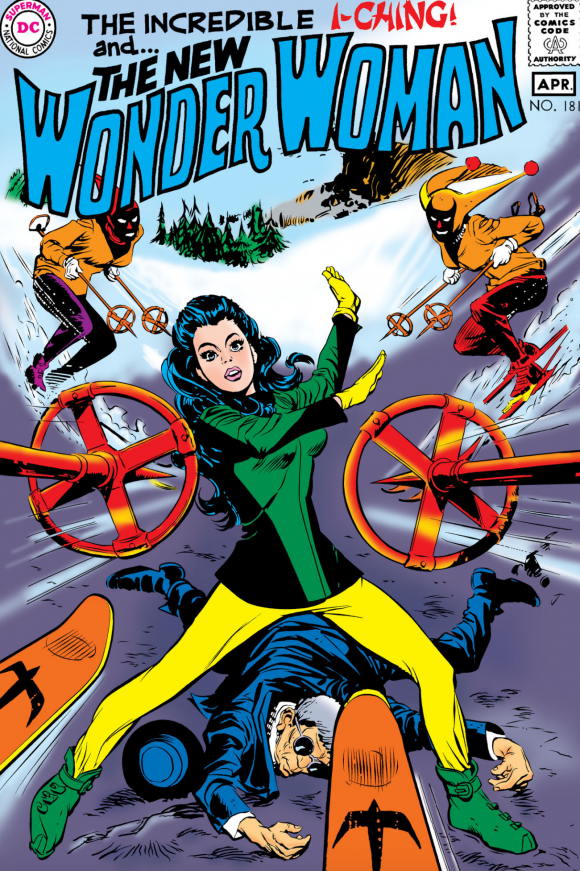
Dick Giordano inks
Denny O’Neil was originally tasked with writing the stories of “the new Wonder Woman,” one stripped of her Amazon superpowers and costume to reduce her to just another well-trained but very mortal heroine. And one who needed a man (her new mentor, I-Ching) to guide her on her way. Gloria Steinem called bullshit. Denny would later apologize for the well-intended but ultimately sexist change to the character.
Sekowsky, who took over editing and writing with #182 didn’t seem to have any quarrel with the format and raced ahead with his usual abandon, largely staying away from typical superhero fare in favor of tales of espionage, adventure and even some of Wonder Woman’s own mythology. The Diana as pantsuited non-superheroine lasted a few issues past Sekowsky’s departure, and by #204 (Jan.-Feb. 1973), she was back in costume and back under Kanigher’s creative control.

Giordano inks
—
6. Adventure Comics #397-409 (Sept. 1970–Aug. 1971). After her original decade-long run as the back-up feature in Action Comics, Supergirl was finally awarded “her own magazine,” the lead spot in Adventure Comics beginning with #381. Though still overseen by Mort Weisinger, the same editor as for her Action run, the charm had gone out of her new, expanded adventures. Maybe it was the burden of finally having to carry a title on her own, of needing that “Wow!” moment for a cover image.
If ever there was character who needed a change in direction it was Supergirl. There was nothing special about her anymore by the end of the ’60s. Male-dominated comics clearly had trouble giving female characters the same weight and importance as their male counterparts. How many male superheroes as powerful as Supergirl would have put up with being kept locked away in the basement as a “secret weapon” while Superman took the limelight? And how many male superheroes ever cried (Choke! Sob!) over girlfriend problems?
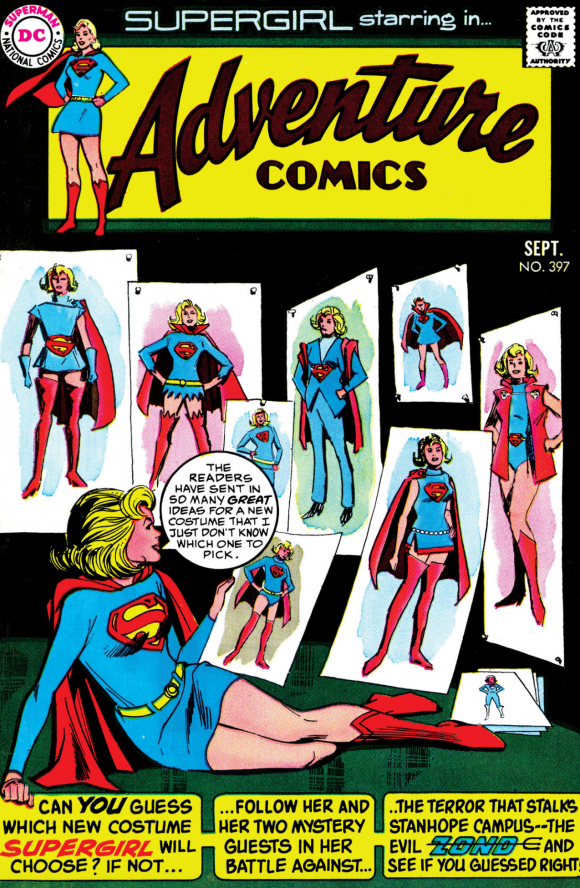
Giordano inks
So, naturally, Sekowsky kicked off his run as editor, writer, and penciller in #397 under a cover showing Supergirl lounging on the floor, contemplating fashion sketches for her new costume. And if he did continue to play the girly card on this run (and he did), at least he was trying to find a direction to take the character. (Although there was an ongoing subplot about her powers mysteriously switching off and on that’s too close to the de-powered Wonder Woman for comfort.) Why were they so scared of women having power?
—
7. T.H.U.N.D.E.R. Agents #1–20 (Tower Comics, Nov. 1965-Nov. 1969). Once upon a time, someone said to Wally Wood, “Here’s a comic book company. Give us something to publish,” and lo, Wally and writer Len Brown created the T.H.U.N.D.E.R. Agents, a costumed take on the current James Bond/Man from U.N.C.L.E. spy craze.
The T.H.U.N.D.E.R. (The Higher United Nations Defense Enforcement Reserves) Agents were Dynamo, No-Man, Lightning, Menthor, and Raven, each member dependent on some gadget or gizmo for their superpowers. There wasn’t much plot to any of the typical storie, but the art, by the likes of Wood, Dan Adkins, Reed Crandall, Gil Kane, George Tuska, Sekowsky, and others, was always top notch.
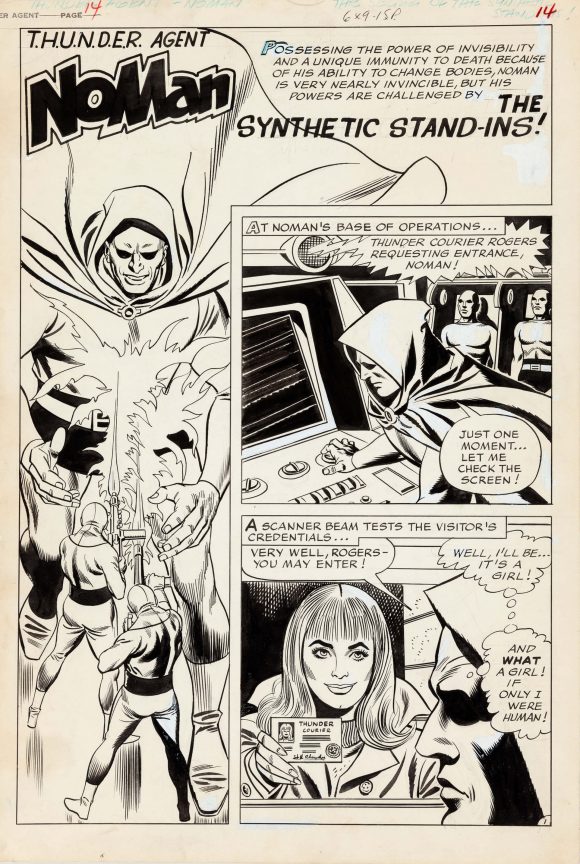
Issue #4, Frank Giacoia inks
Sekowsky had his hand in several of the strips, including the T.H.U.N.D.E.R. Squad, Menthor, NoMan, and Lightning, all the while continuing to produce regular work for DC and Gold Key.
—
8. The Man from U.N.C.L.E. #6-14 (Gold Key, 1966-67). For the sake of a good double-segue, I remembered being surprised to find Sekowsky’s art in several issues of the Man from U.N.C.L.E. comic book (that’s #1), published by Gold Key (that’s #2). Though uncredited, it was obvious that the same guy drawing my beloved Justice League of America had also drawn these stories.

Issue #10, Mike Peppe inks
Like most aspects of comic book art and cartooning, Sekowsky was fairly adept at capturing the essence if not the exact likenesses of stars Robert Vaughn, David McCallum and Leo G. Carroll. But where it really counted — keeping the story moving and the action big — Sekowsky didn’t disappoint, even if he might have stinted a little on the backgrounds to help speed along a job that paid a lower page rate.
—
9. Showcase #88–90 (Feb. 1970 – April 1970). “And Then Came Bronson” (NBC, September 1969), who was himself an “Easy Rider” (1969, directed by Dennis Hopper) who inspired a whole bunch of motorcycle, life-on-the-road tales across all media. Comics didn’t escape the trend (although Marvel’s motorcycle riding Ghost Rider didn’t debut until 1972), which for DC came in the form of Sekowsky’s Jason’s Quest.
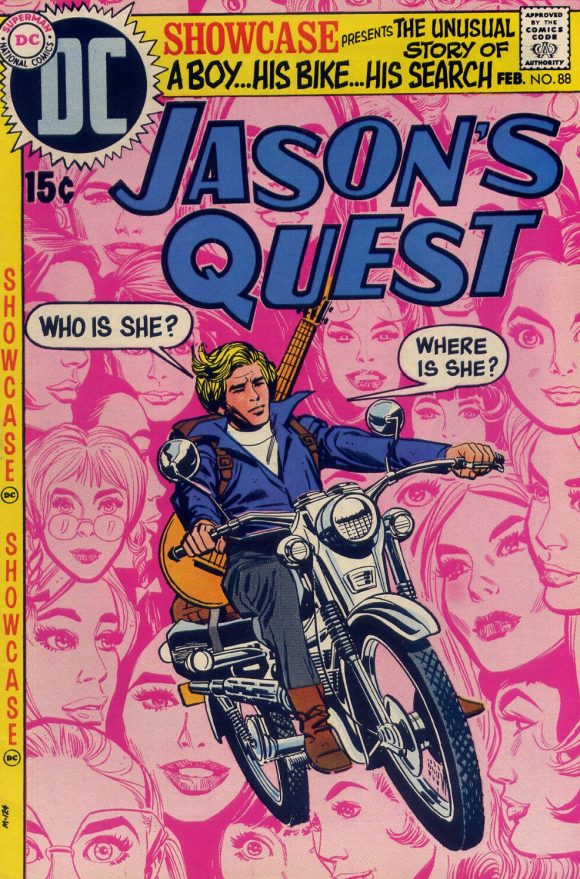
Giordano inks
Even at the time, I wondered if DC really expected this to take off into its own ongoing title. But this was at the very tail end of an era when comics were published in all genres; Charlton Comics still had a healthy line of hot rod and racing comics, but primetime melodrama on two wheels didn’t catch on with readers of the time. I liked it, but I had already developed a taste for strange concepts and interesting loser characters, plus I was always willing to give a Sekowsky story a look.
Jason is a young man who learns that the man he thought was his father was on the run from a mobster and that he (gasp!) has a sister he’s never known. Now, Jason is off on a quest to find out the truth and his long-lost sister. He would get as far as three issues in this Sekowsky edited, written, and penciled tale before pretty much falling off the face of the Earth forever.
—
10. Showcase #91–93 (Feb. 1970–April 1970): Perhaps if Jason of the abovementioned quest had literally fallen off the face of the Earth, he might have bumped into Sekowsky’s next creation, Manhunter 2070, a science fiction bounty hunter in space.
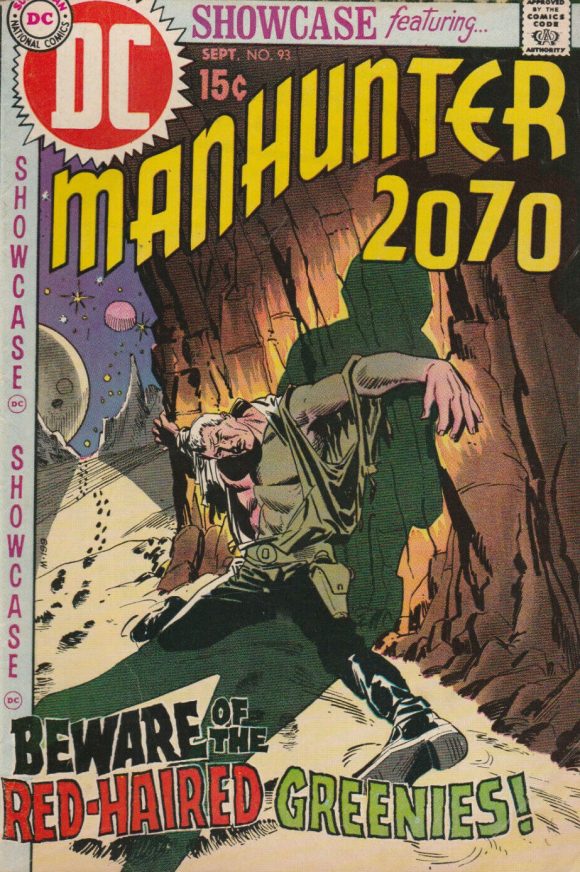
Giordano inks
Manhunter 2070 was way less high concept than Jason’s Quest but no more successful. It would be the death of Showcase, the last gasp of a long and storied title, as it ran out of steam after its three-issue tryout. But Sekowsky was at least trying something different and he’d been paying attention to what was going on at Marvel, opening up the story to pages with fewer panels and dramatic splashes.
Manhunter 2070 was one of my favorite outings by Sekowsky as a writer. He was spinning an interesting tale about Starker, an intriguing character, feeding the readers his back story a little bit at a time. Issue #93 ends with a cliffhanger and a warning that whether or not the reader learns if Starker will survive is up to “the buying public.” Poor Starker!
—
11. Showcase #21 (July/Aug. 1959). In doing the research to write this, I was surprised to discover that Sekowsky only ever did one issue of Rip Hunter, Time Master, the second of the character’s three Showcase appearances (which was followed by a 29-issue run in his own title). I coulda sworn there were more, but for some reason this one issue stuck with me.
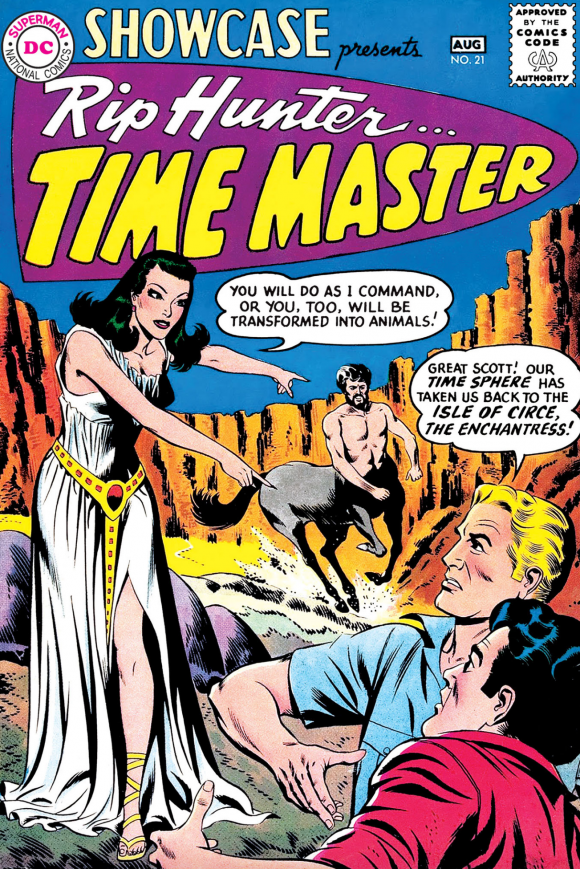
Giella inks
In “The Secret of the Lost Continent,” written by Jack Miller, Rip and company ride the Time Sphere back to 331 BC to meet Alexander the Great and save his bacon in order to get the goods on a map revealing the location of the lost continent of Atlantis. In subsequent chapters, the crew crosses paths with beings out of Greek mythology and, ultimately, find their way to the Atlantean continent in 14,000 BC just in time to save its inhabitants — aliens from the planet Jexjera — from sinking into the sea with it.
It was as absurd as any semi-superhero comic-book adventure strip of the time, but I loved the notion that fabled Atlantis was a colony of aliens who took refuge on Earth after the destruction of their own home world. Isn’t history fascinating?
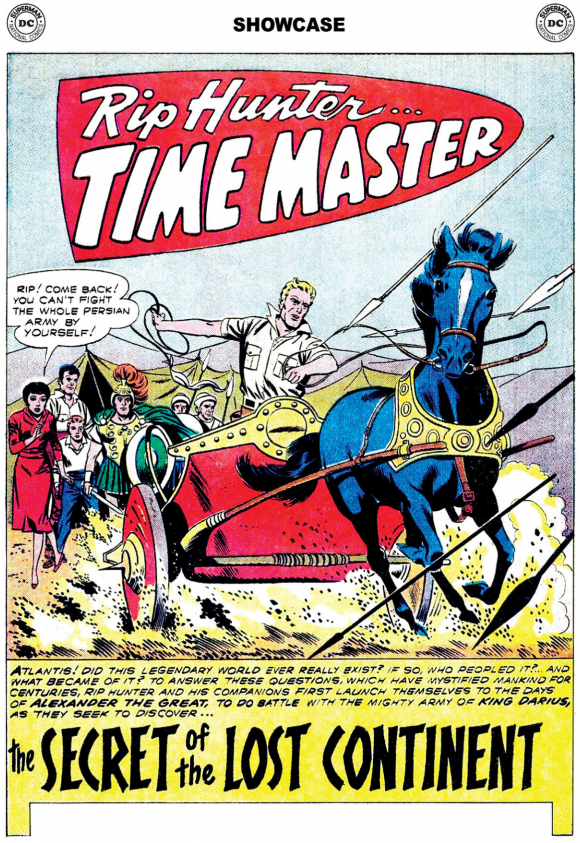
Giella inks
—
12. Ironjaw #1 (Atlas Comics, Jan. 1975): Ironjaw is another instance of my memory making a mountain out of a molehill; like Rip Hunter, Sekowsky did only the one issue of this Atlas barbarian’s five-issue existence, but that’s the one story that sticks out in my memory.
Atlas/Seaboard Comics was the publishing company that Marvel Comics owner Martin Goodman started after he sold Marvel without apparently having to include a non-compete clause in the contract. The company, with editors Larry (Stan’s brother) Lieber and Jeff Rovin at the helm, lasted all of a year and, despite a decent talent roster, never managed to create characters of any real lasting value.
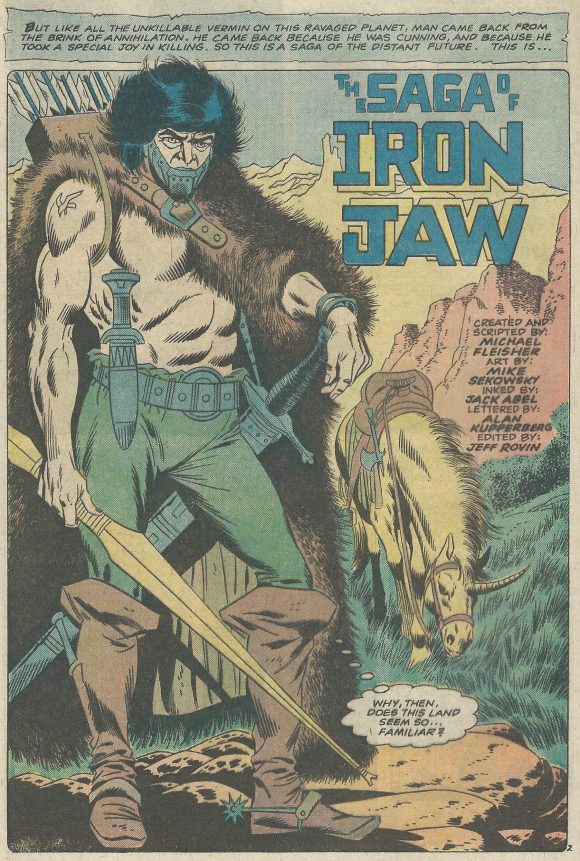
Abel inks
Ironjaw was a nastier, raunchier take on Conan, but, as ever, Sekowsky put his own spin on the character and this story written by Michael Fleisher (who wrote three out of the five; Gary Friedrich wrote the others), was the one that resonated with me.
—
13. Mystery Tales #11 (Atlas Comics, May 1953). If you don’t believe an artist’s style can evolve and change, just go back half a dozen years before Sekowsky’s work on Brave and the Bold #28 to “Love Affair,” a five-pager from one of the soon-to-be-Marvel company’s many genre anthology titles.
I chose “Love Affair” at random (and because you can see it for yourself here, on The Horrors of it All website, but it’s typical of his earlier style; you have to look hard to distinguish Sekowsky (here inked by Christopher Rule) from contemporary work by colleagues like Mike Peppe and Carmine Infantino, but that would change.
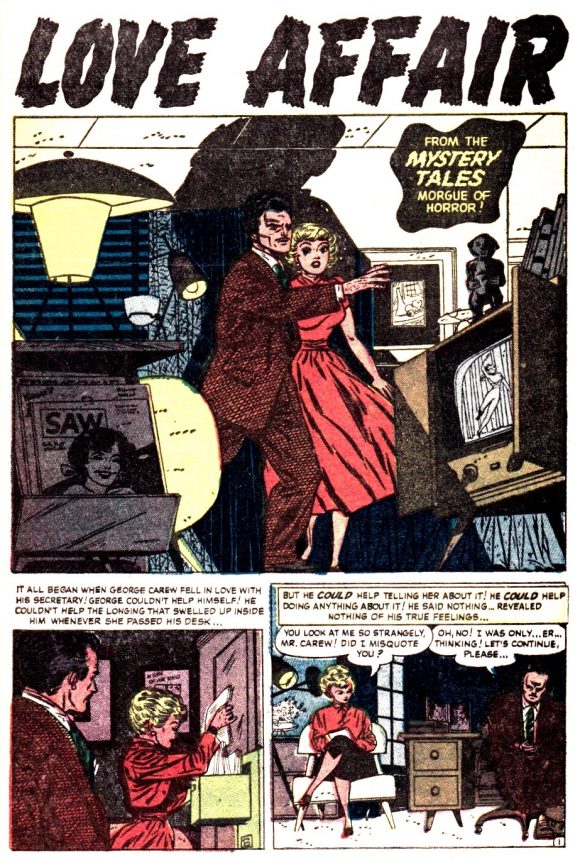
Christopher Rule inks
I don’t know how Sekowsky came to find his new simpler and cleaner 1960s style, but he found something that not only worked for superheroes but could also be adapted for any genre, from superheroes and romance to horror and humor. Maybe it’s just me being a fanboy, but I never read a Mike Sekowsky story I didn’t like.
Happy birthday, Big Mike!
—
Paul Kupperberg has been writing comic books from Archie to Zatanna for 45 years at DC, Archie, Charlton, Marvel, Bongo and others. He is also the author of Paul Kupperberg’s Illustrated Guide to Writing Comics (Charlton Neo Press); I Never Write for the Money… But I Always Turn in the Manuscript for a Check (Comics Career); the comic book industry-based murder mystery The Same Old Story, the short-story collection In My Shorts: Hitler’s Bellhop and Other Stories, and JSA: Ragnarok (all from Crazy 8 Press), all of which are currently — or shortly will be — available at Amazon.
—
MORE
— 13 COVERS: A MIKE SEKOWSKY Birthday Celebration. Click here.
— PAUL KUPPERBERG: My 13 Favorite Short-Lived Series of the 1960s. Click here.

November 19, 2020
Happy birthday to the late Mr. Sekowsky. May he rest in peace.
November 20, 2020
You sure it was Jack Miller’s choice to replace Andru & Esposito on Metal Men? I always thought he lost them to The Flash…
November 21, 2020
Those early JLA books, that’s where I sort of started to get a sense that different guys drew the books, that it wasn’t just one person. Or that it sunk in. Sort of started with Boring/Plastino/Swan on the Superman books but really came home with Sekowsky’s Superman — looked so different from the one in Weisinger’s books, specially with the awful inks of Bernard Sachs. (If I recall, Sachs was a Schwartz buddy and, to be honest, it seemed that artists who worked for Schwartz seemed to get the gigs independent of actual talent but more or less at random. Schwartz just happened to use Infantino at his peak, got Kubert on Hawkman somehow, used Gil Kane who he may have actually despised, etc.)
November 25, 2020
I’d also recommend Inferior Five #6, where we get to see Mike draw many of the DC staff.
November 22, 2021
I thought I had read somewhere that the Atlas/Seaboard line was squeezed out by a distribution maneuver instigated by the folks at Marvel. Maybe I misheard that… I’d love to see an article on that company and their brief output!
September 30, 2022
OMG! Noman was also “The Missing Fink,” in Inferior Five #1. Their riff on U.N.C.L.E.: “C.O.U.S.I.N.F.R.E.D.” I didn’t know that until now! I.5 #1 was the first comic I ever bought at a used store way, way back when!